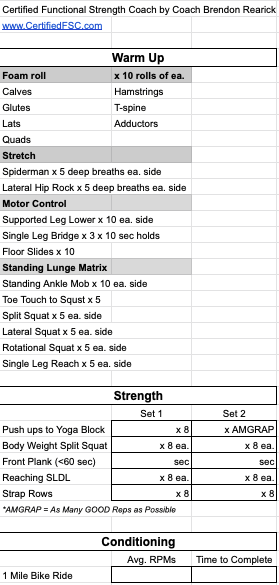Written in conjunction with Strength Coach Podcast Ep. 307
Today, in part two of the “Learn To Coach series” we dive into the movement assessment and assessment workout.
At Certified Functional Strength Coach we find the systematic approach of the Functional Movement Screen (FMS) to be the most useful tool for screening patterns before layering on strength and speed. The FMS tells us if the joints are able to get into the necessary positions to optimally perform the action. If they can’t, we intervene with a corrective exercise and retest the screen to see if it improved.
In coaching terms, our good friend and CFSC coach Drew Massey said it best:
“The FMS tells you when you can put your foot on the gas and when to put your foot on the brake.”
Don’t use the Functional Movement Screen or you’re unfamiliar with it?
No problem. Any movement assessment of your choosing can work here, what’s important is that you’re assessing and not guessing. This process will lead to better exercise selection based on the individuals current abilities and not exercise selection based on what you think they can do, what they tell you they can do, what they want to be able to do, or what they used to be able to do.
We want to meet the client where they’re at today, then progress them safely to where they want to be.
After our initial movement assessment we take them through our “assessment workout”. If you use the same first workout consistently then every exercise can be a screen. We keep this first workout incredibly simple and scalable.
What does this initial workout include?

The Warmup (10 minutes)
The Strength Circuit (20 minutes)
X 2 Rounds
Conditioning (3-5 minutes)
Again we select drills that are low risk, easy to scale and simple to do. Your first conversation and initial assessment will take 25 to 30 minutes. The first workout assessment is meant to take 30 to 35 minutes for a total of 60 minutes. I hope this helps you with creating your own “assessment workout” that you can use with new clients that will give you vital information for creating phase 1 of their program along with issuing any follow up testing that needs to be done at a late time.
I’ll end this segment with one of my favorite quotes to describe the assessment process and that is:
“You can observe a lot just by watching.” ~ Yogi Berra
ARE YOU CERTIFIED YET?
Our Certified Functional Strength Coach Level 1 Online Course is designed to provide you with the same experience you’d get attending our live Level 1 workshop. Complete with the same pre-workshop materials, our Online Course includes a ‘Virtual Live Workshop’, where you will follow a CFSC instructor through an entire Level 1 Workshop complete with instruction, demonstration and question and answer as if you were spending the day at Mike Boyle Strength and Conditioning. Keeping with our rigorous practical standards, all enrollees will be required to complete an online exam and a coaching practical featuring video and open ended questions to complete their certification.